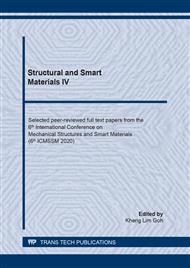[1]
Tran T. H., Luu A. T., Nguyen Q. T., Le H. K. Hoang, T. D. Vu, Vu, N. P. (2020). A Study on Calculation of Optimum Exchanged Grinding Wheel Diameter when Surface Grinding Stainless Steel. Materials Science Forum, 977, 3–11. https://doi.org/10.4028/www.scientific.net/ msf.977.3.
DOI: 10.4028/www.scientific.net/msf.977.3
Google Scholar
[2]
Tran, T. H., Hoang, X. T., Le, H. K., Nguyen, Q. T., Nguyen, T. T., Nguyen, T. T. N., Jun, G., & Vu, N. P. (2020). A Study on Cost Optimization of External Cylindrical Grinding. Materials Science Forum, 977, 18–26. https://doi.org/10.4028/www.scientific.net/msf.977.18.
DOI: 10.4028/www.scientific.net/msf.977.18
Google Scholar
[3]
Hung, L. X., Lien, V. T., Pi, V. N., & Long, B. T. (2019). A Study on Coolant Parameters in Internal Grinding of 9CrSi Steel. Materials Science Forum, 950, 24–31. https://doi.org/10.4028/www.scientific.net/msf.950.24.
DOI: 10.4028/www.scientific.net/msf.950.24
Google Scholar
[4]
Tu, H. X., Pi, V. N., & Jun, G. (2019). A Study on Determination of Optimum Parameters for Lubrication in External Cylindrical Grinding Base on Taguchi Method. Key Engineering Materials, 796, 97–102. https://doi.org/10.4028/www.scientific.net/kem.796.97.
DOI: 10.4028/www.scientific.net/kem.796.97
Google Scholar
[5]
Le Xuan Hung, Vu Ngoc Pi, Luu Anh Tung, Hoang Xuan Tu, Gong Jun and BanhTien Long. Determination of Optimal Exchanged Grinding Wheel Diameter when Internally Grinding Alloy Tool Steel 9CrSi. In IOP Conference Series: Materials Science and Engineering. (2018). IOP Publishing.
DOI: 10.1088/1757-899x/417/1/012026
Google Scholar
[6]
Tran, T.-H., et al., Optimization of replaced grinding wheel diameter for minimum grinding cost in internal grinding. Applied Sciences, 2019. 9(7): p.1363.
DOI: 10.3390/app9071363
Google Scholar
[7]
Tran, T.-H., et al., Optimization of Replaced Grinding Wheel Diameter for Surface Grinding Based on a Cost Analysis. Metals, 2019. 9(4): p.448.
DOI: 10.3390/met9040448
Google Scholar
[8]
Hoang Xuan Tu, Gong Jun, LX Hung, LA Tung, VN Pi. Calculation of optimum exchanged grinding wheel diameter when external grinding tool steel 9CrSi. International Journal of Mechanical Engineering and Robotics Research Vol. 8, No. 1, January (2019).
DOI: 10.18178/ijmerr.8.1.59-64
Google Scholar
[9]
Tu, H.X., et al. Influence of dressing parameters on surface roughness of workpiece for grinding hardened 9XC tool steel. in IOP Conference Series: Materials Science and Engineering. 2019. IOP Publishing. https://iopscience.iop.org/article/10.1088/1757-899X/542/1/012008/pdf.
DOI: 10.1088/1757-899x/542/1/012008
Google Scholar
[10]
Ngoc-Pi Vu ., et al., Optimization of Grinding Parameters for Minimum Grinding Time When Grinding Tablet Punches by CBN Wheel on CNC Milling Machine. Appl. Sci. 2019, 9, 957;.
DOI: 10.3390/app9050957
Google Scholar
[11]
Jack Palmer et al., An experimental study of the effects of dressing parameters on the topography of grinding wheels during roller dressing. Journal of Manufacturing Processes. Volume 31, January 2018, Pages 348-355. https://doi.org/10.1016/j.jmapro.2017.11.025.
DOI: 10.1016/j.jmapro.2017.11.025
Google Scholar
[12]
Davide Matarazzoa et al., Prediction of dressing in grinding operation via neural networks. 10th CIRP Conference on Intelligent Computation in Manufacturing Engineering - CIRP ICME. Procedia CIRP 62 ( 2017) p.305 – 310.
DOI: 10.1016/j.procir.2017.03.043
Google Scholar
[13]
P. Puertoa et al., Evolution of surface roughness in grinding and its relationship with the dressing parameters and the radial wear. The Manufacturing Engineering Society International Conference, MESIC 2013. Procedia Engineering 63 (2013) p.174 – 182.
DOI: 10.1016/j.proeng.2013.08.181
Google Scholar
[14]
Chekole, N.; Deshpande, V. Review analysis on optimization of cylindrical grinding process parameters by using Taguchi technique. Ind. Eng. J. 2018, 14, 35–39.
DOI: 10.26488/iej.11.5.1066
Google Scholar
[15]
Hong-Seok Byun, Seok-Hee Lee. Design of a piston forging process using a hybrid Taguchi method and multiple criteria decision-making. Journal of Mechanical Science and Technology 31 (4) (2017).
DOI: 10.1007/s12206-017-0334-7
Google Scholar


